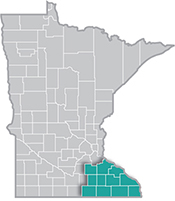 Southeast Minnesota is a health care and agricultural powerhouse. The region is home to the renowned Mayo Clinic and some of the world's most recognized food companies and brands.
Southeast Minnesota is a health care and agricultural powerhouse. The region is home to the renowned Mayo Clinic and some of the world's most recognized food companies and brands.
Advanced manufacturing is especially strong here, with machinery, chemicals, and electronics among the top products.
Want the freshest data delivered by email? Subscribe to our regional newsletters.
1/28/2021 9:00:00 AM
Health Care and Social Assistance is the largest industry by employment in Southeast Minnesota, making up over one-quarter of the total jobs in the region. While it may seem counterintuitive, the industry is not immune to the employment impact of the COVID-19 pandemic. In fact, it lost over 4,000 jobs from the first to the second quarter of 2020, equaling a drop of 6%. Additionally, all four sub-sectors in Health Care and Social Assistance, which includes Ambulatory Health Care Services, Hospitals, Nursing and Residential Care Facilities, and Social Assistance, saw a loss of jobs (see Table 1) during that time frame.
| Industry Title | Number of Jobs | Numeric Change | Percentage Change | |
|---|---|---|---|---|
| 1st Qtr. 2020 | 2nd Qtr. 2020 | |||
| Total, All Industries | 242,773 | 220,789 | -21,984 | -9.1% |
| Health Care and Social Assistance | 66,734 | 62,701 | -4,033 | -6.0% |
| Ambulatory Health Care Services | 33,243 | 31,194 | -2,049 | -6.2% |
| Offices of Physicians | 27,780 | 26,342 | -1,438 | -5.2% |
| Offices of Dentists | 1,502 | 1,104 | -398 | -26.5% |
| Offices of Other Health Practitioners | 1,056 | 915 | -141 | -13.4% |
| Outpatient Care Centers | 593 | 560 | -33 | -5.6% |
| Home Health Care Services | 1,191 | 1,174 | -17 | -1.4% |
| Hospitals | 15,248 | 14,478 | -770 | -5.0% |
| Psychiatric and Substance Abuse Hospitals | 69 | 67 | -2 | -2.9% |
| Nursing and Residential Care Facilities | 11,364 | 11,129 | -235 | -2.1% |
| Nursing Care Facilities (Skilled Nursing Facilities) | 4,943 | 4,891 | -52 | -1.1% |
| Residential Intellectual & Developmental Disability, Mental Health & Substance Abuse Facilities | 2,724 | 2,553 | -171 | -6.3% |
| Continuing Care Retirement Communities and Assisted Living Facilities for the Elderly | 2,687 | 2,685 | -2 | -0.1% |
| Other Residential Care Facilities | 1,009 | 999 | -10 | -1.0% |
| Social Assistance | 6,878 | 5,899 | -979 | -14.2% |
| Individual and Family Services | 4,389 | 3,919 | -470 | -10.7% |
| Community Food and Housing, and Emergency and Other Relief Services | 164 | 160 | -4 | -2.4% |
| Vocational Rehabilitation Services | 847 | 624 | -223 | -26.3% |
| Child Day Care Services | 1,477 | 1,195 | -282 | -19.1% |
| Source: DEED Quarterly Census of Employment and Wages | ||||
The largest job loss was seen in Ambulatory Health Care Services, which lost over 2,000 jobs from the first to the second quarter of 2020, equaling a decrease of 6.2%, due in part to a decline in the number of elective procedures performed. The largest numeric job losses in this sector were experienced in Offices of Physicians (-1,438 jobs or -5.2%) and Offices of Dentists (-398 jobs or -26.5%). Hospitals also experienced significant job loss after dropping 770 jobs during this time frame for a decrease of 5%. Nursing and Residential Care Facilities and Social Assistance also saw job loss, with the former losing 235 jobs (-2.1%) and the latter dropping 979 jobs (-14.2%), in part due to limiting of activities to help keep residents safe.
Much like for many COVID-19 patients, recovery from the pandemic is going to take some time. Current Employment Statistics data for the Rochester MSA shows that while many jobs were lost, many of these jobs are already returning. Education and Health Services cut more than 4,300 jobs from March to June; but from June to November, had regained about 2,000 jobs. While that is steady growth, it means the region has still only recovered less than half the jobs that were lost.
As demand for health care services increases, Health Care employers in the region are looking for workers to fill occupations that remain in high demand, including Registered Nurses, Home Health and Personal Care Aides, Nursing Assistants, Paramedics and Licensed Practical Nurses, among many others. Thus, helping job seekers connect to employers that are hiring is going to remain a critical task in the upcoming months. This will also require that people looking to change careers to in-demand health care paths will need help identifying transferable skills and gaining the skills necessary to prepare for these jobs.
Though there are more unemployed workers in January this year compared to January of last year, unemployment has gone down since the initial months of the COVID-19 pandemic. The most recent estimates showing that the Southeast region’s unemployment rate rested at 3.2% in November, compared to the 8.5% peak seen in May of 2020. CareerForce partners in the region are working hard to reach out to job seekers to share the opportunities in health care.
Contact Mark Schultz.